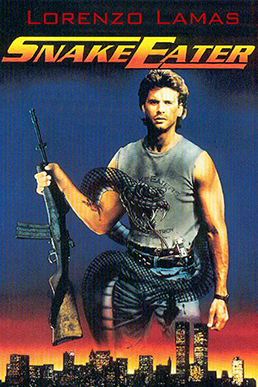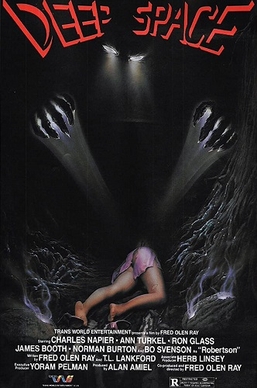
Gary Busey is an American actor. He portrayed Buddy Holly in The Buddy Holly Story (1978), for which he was nominated for the Academy Award for Best Actor and won the National Society of Film Critics Award for Best Actor. His other starring roles include A Star is Born (1976), D.C. Cab (1983), Silver Bullet (1985), Eye of the Tiger (1986), Lethal Weapon (1987), Hider in the House (1989), Predator 2 (1990), Point Break (1991), Under Siege (1992), The Firm (1993), Drop Zone (1994), Black Sheep (1996) and Lost Highway (1997).

Above the Law is a 1988 American crime action thriller film cowritten, coproduced and directed by Andrew Davis. It marked the film debut of Steven Seagal, who was also a producer, and stars Pam Grier, Sharon Stone, Ron Dean and Henry Silva. Seagal plays Nico Toscani, an ex-CIA agent, Aikido specialist and a Chicago policeman who discovers a conspiracy upon investigating the mysterious shipment of military explosives seized from a narcotics dealer.

The Buddy Holly Story is a 1978 American biographical musical drama film directed by Steve Rash which tells the life and career of rock and roll musician Buddy Holly. It features an Academy Award-winning musical score, adapted by Joe Renzetti and Oscar-nominated lead performance by Gary Busey. The film also stars Don Stroud, Charles Martin Smith, Conrad Janis, William Jordan, and Maria Richwine, who plays María Elena Holly.

Lethal Weapon is a 1987 American buddy cop action-comedy film directed and co-produced by Richard Donner, written by Shane Black, and co-produced by Joel Silver. It stars Mel Gibson and Danny Glover alongside Gary Busey, Tom Atkins, Darlene Love, and Mitchell Ryan.

Rambo III is a 1988 American action film directed by Peter MacDonald and co-written by Sylvester Stallone, who also reprises his role as Vietnam War veteran John Rambo. A sequel to Rambo: First Blood Part II (1985), it is the third installment in the Rambo franchise.
To be bulletproof is to embody a bulletproofing technology.

Eye of the Tiger is a 1986 American action film directed by Richard C. Sarafian, and stars Gary Busey, Yaphet Kotto, Denise Galik, Seymour Cassel, William Smith, and Judith Barsi. Busey plays a wrongfully incarcerated ex-convict who fights back against the biker gang harassing his hometown and the crooked sheriff protecting them. The film marked the beginning of the actor's transition to the action roles that would epitomize his career for much of the late 1980s and 1990s.
Fred Olen Ray is an American film producer, director, and screenwriter of more than 200 low-to-medium-quality feature films in many genres, including horror, science fiction, action/adventure, erotic thrillers, crime dramas, and holiday films.
Gailard Sartain is a retired American actor who frequently played characters with roots in the South. He was a regular on the country music variety series Hee Haw. He is also known for his roles in three of the Ernest movies and the TV series Hey Vern, It's Ernest!, which ran for one season on CBS in 1988. He is also an accomplished and successful painter and illustrator.

Snake Eater is an action thriller film directed by George Erschbamer, starring Lorenzo Lamas, Josie Bell, Robert Scott and Ronnie Hawkins. Released on March 10, 1989, it was Lamas' first action film, and Cinépix's attempt at the type of action vehicle that was popular at the time. Harkening back to the Canadian company's grindhouse roots, it infused the veteran vigilante storyline found in many contemporary films with "hicksploitation" elements, which many reviewers found distasteful but did not prevent its commercial success. Three more installments followed between 1991 and 1997.
The following are the Pulitzer Prizes for 1938.

The Tomb is a 1986 American supernatural horror film directed by Fred Olen Ray and starring Michelle Bauer, Richard Alan Hench, David Pearson and Susan Stokey. Despite being respectively given first and second billing, Cameron Mitchell only has a supporting role, and John Carradine features in single scene. Sybil Danning also only appears in the prologue, despite being prominently shown on the poster. The plot concerns an ancient Egyptian vampire who kills those in possession of artifacts stolen from her and taken to the United States by grave robbers.

Cyclone is a 1987 science fiction action film directed by Fred Olen Ray, starring Heather Thomas, Jeffrey Combs, Martine Beswick, Huntz Hall and Martin Landau. It concerns a woman who must keep the ultimate motorcycle from falling into the wrong hands.
Space Rage, also known as Space Rage: Breakout on Prison Planet is a 1985 American space Western film directed by Conrad E. Palmisano.
Steve Carver was an American film director, producer, and photographer.
CineTel Films Inc. was an independent film production company and distributor based in West Hollywood, California.

Deep Space is a 1988 sci-fi horror film directed by Fred Olen Ray, starring Charles Napier, Ann Turkel and Bo Svenson. Napier stars a cop trying to stop the murderous rampage of an escaped creature engineered by the government.

Sharknado: The 4th Awakens is a 2016 American made-for-television science fiction action comedy disaster film and the fourth installment in the Sharknado film series, following Sharknado, Sharknado 2: The Second One, and Sharknado 3: Oh Hell No!. The film was directed by Anthony C. Ferrante with Ian Ziering, Tara Reid, David Hasselhoff and Ryan Newman reprising their roles from the previous installments. New people joining the cast in the film include Tommy Davidson, Masiela Lusha, Imani Hakim, Cheryl Tiegs and Gary Busey. In the film, Fin Shepard and his allies, five years after the last sharknado, contend with a group of sharknado variants, such as a "cownado" and a "lightningnado".

Mind Twister is a 1994 American erotic thriller film directed by Fred Olen Ray, written by Mark Thomas McGee, and produced by Luigi Cingolani and Smart Egg Pictures.
Rainy Day Friends is a 1985 American drama film written and directed by Gary Kent, starring Esai Morales, Chuck Bail, Janice Rule, Carrie Snodgress and John Phillip Law. Morales plays a Mexican-American teenager who is suffering from cancer, and must learn to cope with the patients and staff at the hospital where he undergoes treatment. It is also known by the video title L.A. Bad.












